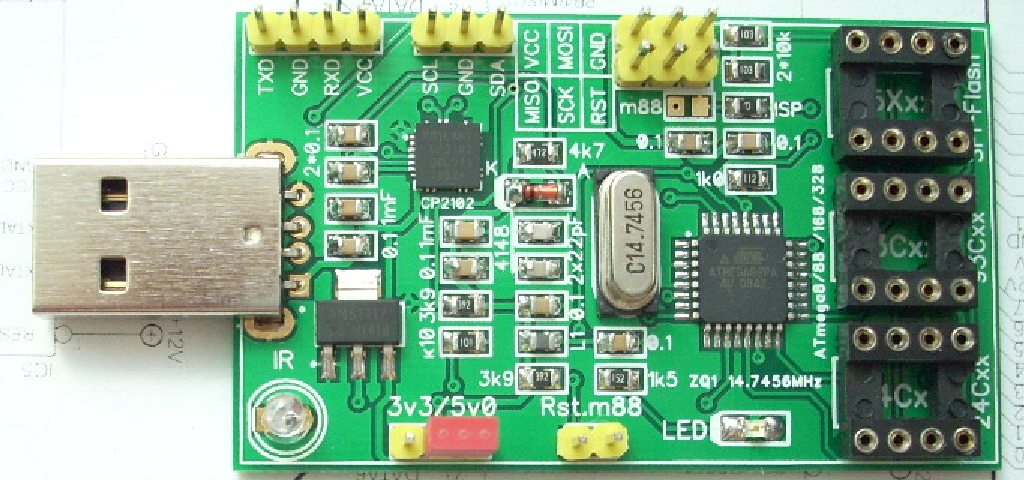
Programming Quad SPI memory devices is a common use case for the Promira™ Serial Platform with SPI Active - Level 1 and 2 Applications.
DLP-USB1232H based SPI programmer schematics In order to use the DLP-USB1232H device as SPI programmer you have to setup a small circuit (e.g. On a breadboard). See the schematics for details (you can also for easier printing). What you will need: Quantity Device Footprint Value Comments 1 — —. 1 Breadboard — —. Many Jumper wires — —.
1 DIP-8 SPI chip — — This is the chip you want to program/read/erase. 1 3.3V voltage regulator TO-220 3.3V E.g. LD33V or LD1117xx. 1 Electrolytic capacitor single ended 100nF.
1 Electrolytic capacitor single ended 10uF. Instructions and hints: • You must connect/shorten pins 8 and 9, which configures the device to be powered by USB. Without this connection it will not be powered, and thus not be detected by your OS (e.g.
It will not appear in the lsusb output). • You need a 3.3V voltage regulator to convert the 5V from USB to 3.3V, so you can power the 3.3V SPI BIOS chip.
• You can probably use pretty much any 3.3V voltage regulator, e.g. LD33V or LD1117xx. For usage on a breadboard the TO-220 packaging is probably most useful. • You have to connect two capacitors (e.g.
100nF and 10uF as per datasheets, but using two 10uF capacitors, or even two 47uF capacitors also works in practice) as shown in the schematics, otherwise the voltage regulator will not work correctly and reliably. • Connect the following pins from the DLP-USB1232H to the SPI BIOS chip: • 18 (SK) to SCLK • 16 (DO) to SI • 2 (DI) to SO • 5 (CS) to CS# • The WP# and HOLD# pins should be tied to VCC! If you leave them unconnected you'll likely experience strange issues. • All GND pins should be connected together ( pins 1 and 10 on the DLP-USB1232H, pin 8 on the SPI chip, pin 1 on the voltage regulator).
You have to invoke flashrom with the following parameters: $ flashrom -p ft2232_spi:type=2232H,port=A On older flashrom versions the syntax was: $ flashrom -p ft2232_spi:ft2232_type=2232:port=A Photos: •. Module and parts FTDI FT2232H Mini-Module The () can be used with flashrom for programming SPI chips. Where to buy: FTDI FT4232H Mini-Module The () can be used with flashrom for programming SPI chips. Where to buy: openbiosprog-spi is an Open Hardware USB-based programmer for SPI chips, designed.
It uses an FTDI FT2232H chip and features either a DIP-8 socket or a pinheader where jumper-wires can be attached. The user-space source code is part of flashrom, the schematics and PCB layouts are licensed under the license and were created using the open-source EDA suite (GPL, version 2).
For more information and downloads, including a parts list, Gerber file downloads, recommended Kicad settings, and recommended PCB manufacturer settings, see. Download skin pack yang keren untuk windows 7. Usage: $ flashrom -p ft2232_spi:type=2232H,port=A Photos: •. RushSPI v0.1 Amontec JTAGkey/JTAGkey2/JTAGkey-Tiny The can be used with flashrom for programming SPI chips. And should work, if you add them to ft2232_spi.c ( untested).
To help our previous customers we offer Erase, Program and verify an AT89C2051 in one easy operation! Programator atmel at89c2051. Programs in just 6 seconds! PG2051 - A Programmer for the Atmel AT89C2051, from AirBorn Electronics The AT89C2051 is a 20 pin 8051 compatible microprocessor (including serial port) with 2k of FLASH memory, available from Atmel (see ).
Where to buy: Usage: More info can be found on on. • You need a 3.3V voltage source - see above for details.

• Connect the following pins from the JTAGkey2 to the SPI BIOS chip: • 1 (Vref) to VCC • 5 (MOSI/TDI) to SI • 7 (CS#/TMS) to CS# • 9 (CLK/TCK) to SCLK • 13 (MISO/TDO) to SO • 20 (GND) to GND • The WP# and HOLD# pins should be tied to VCC. The 'Cable pinout' picture below shows the colors on the breakout cable. Amontec JTAGkey-tiny Olimex ARM-USB-TINY/-H and ARM-USB-OCD/-H The (VID:PID 15BA:0004) and (15BA:0003) can be used with flashrom for programming SPI chips.
The (15BA:002A) and (15BA:002B) should also work, though they are currently untested. The following setup can then be used to flash a BIOS chip through SPI. Pin (JTAG Name) SPI/Voltage Source 1 (VREF) VCC (from Voltage Source) 2 (VTARGET) VCC (to SPI target) 4 (GND) GND (from Voltage Source) 5 (TDI) SI 6 (GND) GND (to SPI target) 7 (TMS) CE# 9 (TCK) SCK 13 (TDO) SO On the ARM-USB-TINY, VREF, and VTARGET are internally connected, and all the GND lines (even numbered pins, from 4 to 20) share the same line as well, so they can be used to split VCC/GND between the voltage source and the target. The voltage source should provide 3.0V to 3.3V DC but doesn't have to come from USB: it can be as simple as two AA or AAA batteries placed in serial (2 x 1.5V). Invoking flashrom: You first need to add the -p ft2232_spi option, and then specify one of arm-usb-tiny, arm-usb-tiny-h, arm-usb-ocd or arm-usb-ocd-f for the type.